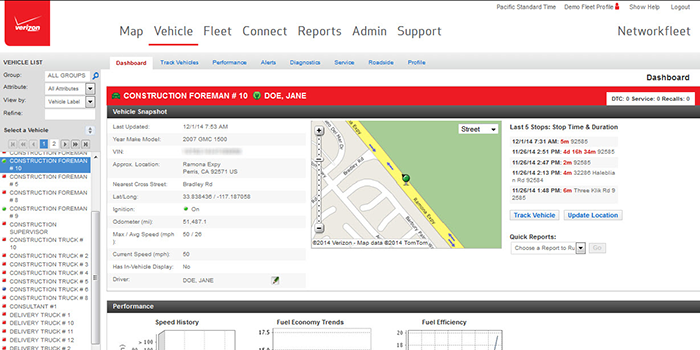With the growing number of onboard applications being utilized by commercial vehicle fleets, addressing needs for communications networks that link with telematics systems is essential. Network requirements, costs and reliability are all increasingly important considerations for an industry that is inherently mobile.
“No one wants to add downtime, so we’re seeing a rising rate of adoption for communications networks that provide real-time visibility for managing commercial vehicles,” says Igor Glubochansky, executive director of big data and advanced solutions for AT&T Mobile and Business Solutions. “In the U.S. today, broad band networks cover 99% of the population, so connectivity isn’t a challenge unless a fleet is operating in a unique environment or a remote location.”
“Fleets should be looking for reliable networks that provide broad coverage and availability in the areas in which they travel and do business,” says Chris Ransom, director of sales engineering at Verizon Networkfleet. “Building and increasing capacity creates opportunities for fleets to take advantage of higher bandwidth and new applications designed for these network capabilities. In addition, significant resources are being used to continually develop a data security infrastructure for fleet customers.”
Verizon Networkfleet’s onboard technology encodes all GPS and diagnostic data collected via a proprietary algorithm prior to transmission over the wireless network. Transmission of the data from the wireless carrier to the Networkfleet Gateway is done via a secure connection. All data retrieved from the Networkfleet application may be obtained using the Secure Sockets Layer (SSL) protocol, an established Internet security standard featuring data encryption, user authentication and database server protection.
AT&T Mobile and Business Solutions, notes Igor Glubochansky, has tested and approved more than 1,200 network-ready on-board devices. “We’re part of the development effort with manufacturers of systems and sensors so we can provide a communications network to fit,” he says. “Fleets want an all inclusive and comprehensive solution, an end to end offering that can be as simple or complex as needed to meet their requirements.”
Verizon Networkfleet’s telematics solution also combines in-vehicle hardware, network transmission software and a web-based application, Ransom notes. The products, he adds, are designed to operate in rugged environments and a variety of weather conditions.
On-board technology
While communications systems from companies like AT&T and Verizon enable fleets to track, monitor and manage their vehicles cost effectively and reliably, one of the fastest growing uses of on-board communications are telematics systems from vehicle and component manufacturers:
- Detroit Virtual Technician, a proprietary onboard diagnostics package that is now standard on most Freightliner and Western Star trucks equipped with Detroit engines, is a telematics solution that records critical vehicle performance data immediately before, during and after a fault occurs. Within minutes, the manufacturer’s engineers interpret fault codes, and provide a preliminary diagnosis and service recommendations.
- Mack GuardDog Connect, part of the OEM’s Pedigree Uptime Protection customer support platform, connects trucks to a network of support staff and repair centers. GuardDog Connect detects problems and, if an issue needs immediate attention, contacts Mack’s OneCall customer center with the fault code where technicians identify the exact issue and repairs needed.
- Navistar OnCommand Connection is an open architecture remote diagnostics system for all makes and models of vehicles. The system generates real-time vehicle health reports and addresses fault codes with action plans that provide severity information and recommends solutions.
- Volvo Remote Diagnostics, standard in every new Volvo truck, provides real-time diagnostic and repair planning assistance with detailed analysis of critical fault codes. The result, according to the manufacturer, is a more than 70% reduction in average diagnostic time for targeted faults based on data collected from trucks currently using the service.













